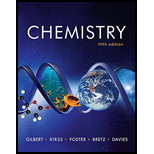
Concept explainers
(a)
Interpretation: The comparison of total pressure after each reaction to the total pressure before the reaction is to be done. All the reactants and products are assumed to be gases at same temperatures
Concept introduction: The pressure of gaseous mixture depends upon the number of moles of gases present in the mixture. Greater the number of moles of gases, greater will be the pressure.
To determine: The comparison of total pressure after each reaction to the total pressure before the reaction.
(b)
To determine: The comparison of total pressure after each reaction to the total pressure before the reaction.
(c)
To determine: The comparison of total pressure after each reaction to the total pressure before the reaction.
(d)
To determine: The comparison of total pressure after each reaction to the total pressure before the reaction.
Want to see the full answer?
Check out a sample textbook solution
Chapter 6 Solutions
Chemistry: The Science in Context (Fifth Edition)
- pls help on all, inlcude all steps.arrow_forward19. Complete the following chart for the incorrect electron configurations shown in the left column. When drawing the correct electron configuration, assume the same number of electrons that were shown in the incorrect configuration. Incorrect Electron Configuration 2p ↑↓ ↑ 2s ↑↓ 1s ↑↓↓ ਵੇ ਵੇ ਵੇ 3p ↑ ↑ ↑ - 38 ↑ 2p 2s ↑↓ 1s 2p 2s 1s ** ↑↓ ↑↓ ↑↑ 리리리 Which principle or rule is violated? Explain the violated principle or rule in your own words Draw the correct electron configurationarrow_forward14.36 Draw all reasonable resonance structures for each compound. a. + b. C. :O: d. :O: NH2 NH2 :O:arrow_forward
- 14.32 What diene and dienophile are needed to prepare each compound by a Diels-Alder reaction? a. b.arrow_forward14.34 Draw all reasonable resonance structures for each species. a. b. Ö :0: C. :0: :0: d. OH e. f. :O:arrow_forward7. The standard reduction potentials for two half-reactions are shown above. Which of the statements listed below will be true for the following reaction taking place under standard conditions? a. E° b. E° c. E° = d. E° e. E° = Al (s) + Cr³+ → Al³+ + Cr (s) 0.93 V, and the reaction is not spontaneous 0.93 V, and the reaction is spontaneous 2.39 V, and the reaction is not spontaneous 2.39 V, and the reaction is not spontaneous 0.93 V, and the reaction is spontaneous Cu2+ + 2e → Cu E° = +0.34 V Zn2+ + 2e → Zn E° = -0.76 V E° = -1.18 V Mn2+ + 2e → Mn 8. Based on the above reduction potential, which of the following reactions will occur spontaneously? a. Mn²+ + Cu → Mn + Cu2+ b. Mn²+ + Zn → Mn + Zn²+ c. Zn2+ + Cu → Zn + Cu²+ d. Zn²+ + Mn → Zn + Mn2+ e. Cu²+ + Zn²+ → Cu + Znarrow_forward
- 14.35 For which compounds can a second resonance structure be drawn? Draw an additional resonance structure and the hybrid for each resonance-stabilized compound. a. OCH3 OCH 3 b. C. d. CH3 NHCH3arrow_forwardpls help on all, inlcude all steps.arrow_forwardpls help on all, inlcude all steps.arrow_forward
 ChemistryChemistryISBN:9781305957404Author:Steven S. Zumdahl, Susan A. Zumdahl, Donald J. DeCostePublisher:Cengage Learning
ChemistryChemistryISBN:9781305957404Author:Steven S. Zumdahl, Susan A. Zumdahl, Donald J. DeCostePublisher:Cengage Learning ChemistryChemistryISBN:9781259911156Author:Raymond Chang Dr., Jason Overby ProfessorPublisher:McGraw-Hill Education
ChemistryChemistryISBN:9781259911156Author:Raymond Chang Dr., Jason Overby ProfessorPublisher:McGraw-Hill Education Principles of Instrumental AnalysisChemistryISBN:9781305577213Author:Douglas A. Skoog, F. James Holler, Stanley R. CrouchPublisher:Cengage Learning
Principles of Instrumental AnalysisChemistryISBN:9781305577213Author:Douglas A. Skoog, F. James Holler, Stanley R. CrouchPublisher:Cengage Learning Organic ChemistryChemistryISBN:9780078021558Author:Janice Gorzynski Smith Dr.Publisher:McGraw-Hill Education
Organic ChemistryChemistryISBN:9780078021558Author:Janice Gorzynski Smith Dr.Publisher:McGraw-Hill Education Chemistry: Principles and ReactionsChemistryISBN:9781305079373Author:William L. Masterton, Cecile N. HurleyPublisher:Cengage Learning
Chemistry: Principles and ReactionsChemistryISBN:9781305079373Author:William L. Masterton, Cecile N. HurleyPublisher:Cengage Learning Elementary Principles of Chemical Processes, Bind...ChemistryISBN:9781118431221Author:Richard M. Felder, Ronald W. Rousseau, Lisa G. BullardPublisher:WILEY
Elementary Principles of Chemical Processes, Bind...ChemistryISBN:9781118431221Author:Richard M. Felder, Ronald W. Rousseau, Lisa G. BullardPublisher:WILEY





